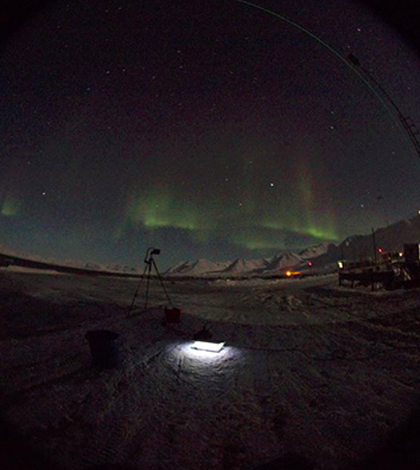Scientists studying krill track light levels during Arctic polar night

The northern lights shimmer above as Jonathan Cohen measures atmospheric light during the Arctic’s polar night. (Credit: University of Delaware)
The Arctic is a fairly well-studied area, but the waters beneath it are something akin to the deep sea in that scientists have yet to tap the true potential they hold. One example of this is the little-known dependency that Arctic krill and phytoplankton have on light at the northern tip of the planet.
From other investigations and past studies, scientists know that light is a trigger for the small marine organisms to move up and down in water columns everywhere, cueing them that it’s safe to search for food or signaling that they should hide from predators. But the Arctic is a special place, and its light patterns don’t conform with those found in other regions of our big blue marble. The Arctic has something called “polar night” — a result of Earth’s shifting that blankets certain spots in darkness for weeks at a time.
For scientists with the University of Delaware studying the effects of the low-to-no light of the Arctic on its small marine organisms, their location at Svalbard, Norway, saw about 84 days of extended darkness.
Since light was so minimal, measuring it underwater wasn’t possible. So the researchers had to measure light above the surface and then estimate the amount penetrating through to the water column using some nifty mathematics. But they took the investigation further, looking not just at the light provided from the sun but also that coming from the bioluminescence of krill and phytoplankton themselves, as well as the shimmering northern lights.
“In the early winter, the sun is higher below the horizon. When you go into December and January, it’s less and less,” said Jonathan Cohen, assistant professor in the College of Earth, Ocean, & Environment at the University of Delaware. “But just because we can’t see it doesn’t mean that organisms can’t use it.”

Scientists studied the bioluminescence of krill and phytoplankton. (Credit: University of Delaware)
Scientists are trying to understand how much atmospheric light is there and how the organisms use it. For bioluminescence, the ability of organisms to produce their own light through photophores, researchers want to understand who produces it, where it is and how the organisms’ light gets used throughout the ecosystem.
“Seabirds prey on bioluminescence and it seems like they’re switching their diet. One of the things we want to find out is: Are they keying on bioluminescence?” said Cohen. “In the wild, bioluminescence is used to avoid predators, in finding prey, finding mates. We know it’s there. It’s abundant.”
To measure organisms’ natural light as well as the light just barely making it into the water column from the sun and sometimes the northern lights, it took a little tinkering.
Since conventional light meters aren’t sensitive enough to make the measures they needed, scientists in Svalbard had to use atmospheric light meters. By using an optical diffuser, they were able to drop the light by 90 percent. From there, a fiber-optic spectroradiometer coordinated with a spectralon plate to integrate light coming in from the sky.

University of Delaware researcher Jonathan Cohen measures the midday light in Svalbard, Norway. (Credit: University of Delaware)
For the northern lights, the effects are mostly tied to the wavelengths that they give off, says Cohen.
“Light that propagates through the water has a wavelength of about 40 to 90 nanometers and the wavelength will affect how far it can go,” said Cohen. “The green ones are pretty good at getting through the water column.”
Making light measurements under the water took a different tack. For that zone, scientists used an underwater bathyphotometer that can measure light given off by any organism that finds its way in.
“We have developed a library of species that produce flashes,” said Cohen. “So we can identify any species by its flash.”
Deeper understanding of those creatures and the light dynamics they live with will become more important in the future, says Cohen.
“The Arctic is a place we want to focus these questions on because of the trends in warming and sea-ice loss,” said Cohen. “But particularly in winter, it’s a pretty unstudied time of the year in the Arctic. That’s changing with collaboration, and we’re trying to shed some light on what’s happening that time of the year.”
The research was funded by the Norway Research Council, and investigators relied on the nearby Ny-Alesund Station as a home base during their work.
Top image: The northern lights shimmer above as Jonathan Cohen measures atmospheric light during the Arctic’s polar night. (Credit: University of Delaware)





0 comments